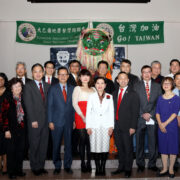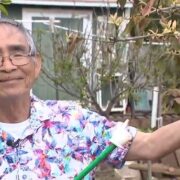History of Taiwanese Association of America
Author: Jason Huang
Which Taiwanese association came first? When was it established? These details are difficult to verify now. From a historical point of view, the first Taiwanese associations were probably started after the Japanese took over. The strength of the Taiwanese consciousness is heavily linked having once endured the high-pressure rule of the Japanese. As early as the 1920s and 30s, there were dozens of Taiwanese groups that, for business, educational, or work-related reasons, had already spread throughout the major Asian cities, like Tokyo, Osaka, Beijing, Shanghai, Guangzhou, and other places. But back then, there were only a few individuals who came to America. Lin Mosei, who is fairly well-known, received his Ph.D. from Columbia University in 1928. But actually, Ching Feng Liu from Tainan had already received his M.D. from Indiana University in 1926, making him the first Taiwanese person to receive an M.D. from the United States. Thomas Liao didn’t receive his Ph.D. from Ohio State until 1935. Over the last six decades since Ching Feng Liu and Lin Mosei came to the U.S., who knows how many Taiwanese have followed in the footsteps of their predecessors, traveling thousands of miles to study, work, and live here. The details of what has happened between then and now are difficult uncover, because there are very few documents left. But, at each different stage of history, Taiwanese associations have played a very important role in the lives of overseas Taiwanese people. Thus, if we can understand a little more about the history of these associations, we will have a clearer understanding of the footprints of the decades of Taiwanese people that lived overseas. Moreover, we might also have a better understanding of our own positionality. This article will serve to give a brief introduction to the history of Taiwanese associations.
One of the unique characteristics of modern Taiwanese organizations is the pivotal role that Taiwanese international student organizations play within them. This is very different from China Town or the areas where Japanese have settled. The most famous and representative of the Taiwanese international student organizations is the Taiwanese Student Association in Tokyo. In 1915, Taiwanese students in Tokyo established the Takasago Youth Association, which they later renamed the Tokyo Taiwan Youth Association. The purpose of the organization was to “cultivate love for the homeland, encourage awareness, and promote the development of Taiwanese culture.” However, the association’s true actions were geared toward promoting Taiwanese self-determination. The first issue of their publication, Taiwan Youth, was published in 1920, and advocated the retraction of Title 63 (Law Relating to Laws and Ordinances to Be Enforced in Taiwan), and fought against the configuration of the Kokkai (or the National Diet, the Japanese legislature). In the 1920s, when students returned home from having studied overseas, they initiated a deeply influential cultural enlightenment movement.
It needs to be understood that all organizations are the product of their historical situation. The thoughts and actions of the Taiwanese students living in Japan in the 1920s were inevitable. However, the surprising part is that over half a century later, the goals of the organizations created by Taiwanese students in the 1920s are still being pursued by Taiwanese people and Taiwanese student organizations everywhere. Compare, for example, the abolition of Title 63 and the abolition of martial law, the movement to reconfigure the Kokkai and today’s movement to completely restructure the parliament, or the national self-determination movement of the 1920s, and today’s resident’s self-determination movement. In the last 60 years, history seems to have stopped for the Taiwanese people. Realistically speaking, it is actually because of these kinds of historical conditions that the purpose and general direction of Taiwanese organizations tend to be more or less set in stone.
In the 1950s, Taiwanese students began trickling into the United States, but it wasn’t until the 1960s that they began to come in great numbers. In the 50s and 60s, ethnically Taiwanese students were a minority among the students who had come from Taiwan to study at college campuses across the States. The majority of students arriving from Taiwan were ethnically Chinese, and there was little contact between the two groups. The situation back then is very different from today. This is mainly because back then there was a greater difference in language, customs, and lifestyle choices, and of course, political factors made up an important part of this divide. Though there were few ethnically Taiwanese students in the 1950s, out of this group rose a number of key individuals. Ironically, this was due to the fact that in the mid 1950s, the Kuomintang sent a number of middle schoolers to study abroad. Supposedly, their goal was to open the back door for children of high-level Kuomintang officers to go abroad (among these students, the most well-known is Chen Li-An). As a result of this project, many Taiwanese children also jumped aboard this train, and this group of Chen Li-An’s classmates played a very important role when Taiwanese students began arriving to the United States in the late 50s and early 60s.
In the beginning, Taiwanese students established Formosan Clubs in their schools, but didn’t register them officially. Later, as the Taiwanese student population increased, they began to form intercollegiate organizations and even set up a fairly large-scale reception center in New York which mostly helped students find part-time work. The creation of a nation-wide register didn’t come until after the mid-60s. The timing of the establishment of each city’s local Taiwanese association varied greatly from place to place. In the 50s, Chicago already had a Taiwanese Association, while the Taiwanese Association of Philadelphia wasn’t established until 1963. Following this, the Taiwanese Association of Washington D.C. was established in 1968, and the Taiwanese Association of Columbus, Ohio in 1972. The early Taiwanese associations encountered many difficulties during their establishment; apart from finding members and raising funds, the greatest obstacle to their creation were political factors. The Kuomintang was extremely hostile towards Taiwanese organization, so participating in a Taiwanese association could bring about a lot of trouble for its members. On the lighter end of the scale, one might get harassed for their participation, on the heavier end of the scale, one could have their passport revoked and their name blacklisted; for this reason, many people shrunk away from participating in Taiwanese associations. Under these kinds of circumstances, those who still chose to organize or lead Taiwanese Associations were the kinds of particularly daring, spirited, and passionate individuals who would “willingly enter the mountains, knowing there are tigers.”
Mr. Ted Lau, a local Taiwanese community member, was the second president of the Taiwanese Association of Columbus. As he remembers it, sometime around 1971, a group of passionate Taiwanese were “wriggling like worms,” anxious to stir up some trouble by organizing a Taiwanese association. But, when their plans started to become a reality, they were inevitably a little scared, and the association wasn’t established. Taiwanese students constantly faced a contraction: if they didn’t organize, it felt difficult to breathe, but if they chose to organize, the results of their actions would be uncertain. If you wanted to break out of this stalemate, you had to be unafraid of death. Ted Lau remembers that back then he was still young, so like “a newborn calf who has not learned to fear tigers,” he became the president of the Taiwanese Association. Later, he began receiving late-night phone calls harassing him, his letters were inspected, and his family in Taiwan was also affected. His experience was, in fact, only a small-scale version of what happened in the 60s and 70s to Taiwanese associations across the United States. Thanks to these historical circumstances surrounding their establishments, Taiwanese associations have an extremely strong tradition of political resistance. Whether in the student publications that were circulated on campus or in the newsletters that were circulated beyond campus, these Taiwanese associations always harshly criticized the autocratic rulership in Taiwan. Today, many association members and new friends have difficulty understanding why cultural and social organizations like Taiwanese associations are so political. If you don’t go back and look at historical context, it’s hard to understand why Taiwanese associations have this tradition. The most prosperous time of the Taiwanese associations’ political tradition was during the 1970s. This is apparent in the establishment of the Taiwanese Association of America – United States of America (TAA-USA) in 1970, and the establishment of the World Federation of Taiwanese Associations (WFTA) in 1974.
In the 1980s, Taiwanese Associations experienced a new change. This change mainly occurred on two fronts. The impact of the Formosa Incident, in addition to the fact that Taiwanese were gradually gaining a foothold in the United States and had accumulated many years of organizational experience, caused overseas Taiwanese organizations to begin dividing up work and diversifying. The establishment of the North American Taiwanese Professor’s Association (NATPA), Formosan Association for Public Affairs (FAPA), and other associations are examples of this period. Especially important to note is that with the amendments made to U.S. immigration law in the 1980s, Taiwanese immigrants (not students) began coming to the United States in large numbers, which had a very significant impact on the demographic structure of the overseas Chinese community. With the ever-increasing numbers of newly immigrated overseas Chinese, Taiwanese associations began to shift from quantitative change to qualitative change. This process became very clear after 1984. As disputes began to rise intermittently, it became clear that the good times of the 70s had already passed. The problem here was actually in the ways that Taiwanese associations responded to the new situation and how they chose to utilize this new strength. If there is the opportunity, I will discuss these issues, as well as the issues regarding to the path of the Taiwanese associations in a separate article. As previously mentioned, all organizations are the products of their historical conditions. On one hand, we should cherish the journey that our predecessors had to take, and value the traditions we’ve inherited. On the other hand, we should continue to examine the limitations that these traditions have, and hope that we can use the foundations laid by our predecessors to expand on our existing achievements. Not all traditions are good, but history cannot be left unknown, and even more so, cannot be forgotten. The claims of those who frequently accuse Taiwanese associations of being too political are inherently correct. Nonetheless, we sincerely hope that these individuals can put a little effort into better understanding the historical circumstances surrounding the development of Taiwanese associations, so that we can look forward to Taiwanese associations that are able to bring together both tradition and forward-thinking aspirations.
Before I conclude this article, it seems valuable to briefly make a comparison to the incident that occurred in China this June (translator’s note: the author is referring to the Tiananmen Square Massacre). The historical conditions behind the events in June have already had a major impact on determining the future direction of the overseas Chinese movement. The various cooperation efforts, divisions, and disputes that have occurred also seem quite predictable. Seeing the Chinese democratic movement receive worldwide attention and support and comparing it with the history of the Taiwanese associations really makes you remember and admire our Taiwanese ancestors who, though lonely, stood steadfast and dignified through that horrible and dark era.
The Taiwanese Association of Washington D.C. was officially established in 1968. Prior to this, the Taiwanese Association was co-organized by Taiwanese in Washington D.C. and Baltimore. The first President of the association, Chi-kun Yang, was the son of Chao-chia Yang. According to him, when he first arrived in Washington D.C. in 1961, there were very few Taiwanese, and most of them were doctors. Most of the gatherings were hosted by the Taiwanese community members who already had families. Among these individuals was Dr. Chi-Chin Huang, who played an extremely important role in the early Taiwanese overseas community. Many events were hosted at Dr. Huang’s home, and the warmth and care he provided to younger members of the Taiwanese community is still missed by many. In the early days of the Taiwanese Association, the majority of activities were mostly informal social gatherings. The association also didn’t have an official charter. Presidents were selected based on a volunteer basis, which is obviously very different from today. By the mid-70s, when Mr. Andrew Y. Lee was in charge, the Taiwanese Association of Washington D.C. had already become increasingly active and was taking shape. When Mr. William Chung became President, he completed the charter, systematized the election process, and set the Taiwanese Association upon the path towards a bright future.
Source from Taiwan Tribune, No. 811 /1989/11/09
Translated from 1. 台灣同鄉會的歷史進程





